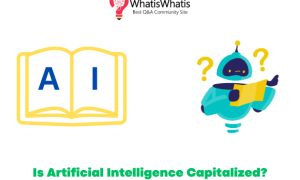What is Machine Learning?
Machine learning is a method of data analysis that automates analytical model building. By applying advanced statistical algorithms to datasets, machine learning uses observed data to determine patterns and relationships automatically, then builds mathematical models based on these patterns. In the process of building the model, it also creates an inferred model that explains what caused those observed patterns.
Read the: 3 Factors Shaping the Future of Big Data & machine learning
Machine learning can be categorized as either supervised or unsupervised learning depending on whether there is a “teacher” who provides feedback during the learning process:
Supervised learning:
The teacher gives the correct answer to the learner and helps correct wrong answers.
Unsupervised learning:
The teacher only provides examples of inputs and outputs so the learner can find structure without any help or feedback.
Once the model is built, new data can be analyzed, and predictions can be made. Depending on how accurate those predictions are, the model can then be used to make better decisions that improve outcomes.
The steps of a machine learning process:
Problem definition:
The first step in a machine learning project is to understand the problem and determine which algorithms will work best for your specific needs. It defines what you want to learn from your data – what questions do you need to answer? What prediction or classification accuracy do you need? What scale of data makes sense for your particular problem?
Data collection and preparation:
Once the problem has been defined, decide how much training data will be required, where it’s coming from, and what format it will be in.
Modeling:
At this stage, the model is built and fits the data. This step can take a long time and requires large amounts of processing power. Data scientists use their understanding of the problem space combined with experience to create dozens or hundreds of possible models and then measure their performance: which ones work best? Which ones don’t generalize well and are prone to overfitting?
Evaluation and fine-tuning:
Once the modeling phase is finished, you begin optimizing your final model by observing how it performs on out-of-sample examples. You also want to make sure that you understand why your model works as well as it does so you can better interpret its results and apply it to new unseen data: Does the model memorize the training data and not understand it?
Was there a correlation between input and output that wasn’t obvious during the modeling step? Refer to RemoteDBA.com to know more.
Presentation:
The final phase is to take what you’ve learned from your analysis and present/communicate the results to other stakeholders. This allows them to make more informed decisions about their future actions using your newly-learned models. Machine learning algorithms have been used for decades to support decision-making in a variety of disciplines.
For example:
Computer vision: Recognizing images and video (e.g., facial recognition systems based on machine learning algorithms)
Speech recognition: involves transcribing human speech; automatic language translation; recognizing conversational commands. Natural language processing: Understanding written or spoken natural language (i.e., understanding input text/speech and producing relevant actions).
Web search: Performing searches to return relevant results (such as Google search).
Robotics: Controlling autonomous robots using sensor data processed by complex algorithms such as machine learning algorithms. The robot uses that information to take any action, like moving forward.
Machine learning algorithms typically follow this general process:
- Initialize parameters
- Repeat until convergence
- Present results
Typically, the initial parameters are set randomly or via other initialization methods (e.g., uniform distribution). The algorithm can be controlled by setting criteria for stopping (“convergence”), which terminates the loop. At that point, the results of performing predictions on new data can be presented/outputted based on what has been learned during the training phase. If more data is needed, then another pass through this loop can occur with updated parameters and no output at all (i.e., iterating over the loop again without stopping).
Machine learning problems can be divided into three main types:
Supervised learning –
Learning from labeled data. This can be used for classification or regression tasks. For example, an algorithm might learn how to predict income based on a person’s salary and years of work experience.
Unsupervised learning –
Learning from unlabeled data. Algorithms that cluster or group unlabeled data together are examples of unsupervised learning. For example, clustering algorithms can be used to automatically group data records based on common features.
Reinforcement learning –
This type of machine learning is typically used for robotics or game playing (e.g., AlphaGo). A reinforcement learning algorithm receives feedback at each step and learns which actions yield the best results.
As it relates to data science, supervised machine learning means training an algorithm with labeled data so that you can make accurate predictions on new unlabeled data later by using the learned parameters from the original labeled dataset.
For example, an email spam classifier’s goal is to create a model using existing labeled emails (spam vs. not spam) so that new unseen emails can be accurately classified as spam or not spam. Unsupervised machine learning means clustering data based on known variables so that new incoming data can be automatically grouped similarly to inform human decision-making.
Reinforcement learning is typically used when there’s a desired outcome from action, and it’s challenging to predict ahead of time what the best course of action will be for achieving that outcome. In robotics, reinforcement learning can help autonomous robots navigate environments or play games with no prior knowledge of rewards/consequences associated with different actions.
Machine learning algorithms fall into one of two main categories: supervised or unsupervised. Supervised machine learning algorithms require a labeled dataset as input, while unsupervised machine learning algorithms do not need labeled data as input.
In supervised machine learning algorithms, a set of known inputs and outputs are given. The algorithm can then analyze the inputs and outputs to predict an output value. In this case, the algorithm learns from historical information to predict the future output.
In unsupervised machine learning, there is no direct output resulting from the data set analysis. Instead, it focuses on finding hidden patterns or trends within a dataset without directly knowing what it represents at first glance. An example could be using PCA (Principal Component Analysis) in statistics to understand large datasets without overwhelming ourselves with all the data collected at once. After applying PCA, we get a reduced number of ‘principle components’ which
Why is AI significant?
Resurging revenue in AI (Artificial Intelligence) is because of the very factors that have made information mining and Bayesian examination more famous than any other time in recent memory. Things like developing volumes and assortments of accessible information, computational handling that is less expensive and all the more impressive, and moderate information stockpiling.
Know: The History of Artificial Intelligence in Detail
These things mean it’s feasible to rapidly and consequently produce models that can dissect greater, more mind boggling information and convey quicker, more exact outcomes – even on an extremely enormous scope. Furthermore, by building exact models, an association has a superior shot at distinguishing productive freedoms – or staying away from obscure dangers.
Who’s utilizing it?
Most ventures working with a lot of information have perceived the worth of AI innovation. By gathering experiences from this information – regularly progressively – associations can work all the more proficiently or gain a benefit over contenders.
Monetary administrations
Banks and different organizations in the monetary business use AI innovation for two key purposes: to distinguish significant bits of knowledge in information, and forestall misrepresentation. The bits of knowledge can recognize speculation openings, or help financial backers realize when to exchange. Information mining can likewise recognize customers with high-hazard profiles, or use cybersurveillance to pinpoint notice indications of extortion.
Government
Government organizations, for example, public wellbeing and utilities have a specific requirement for AI since they have numerous wellsprings of information that can be dug for experiences. Examining sensor information, for instance, recognizes approaches to build effectiveness and set aside cash. AI can likewise assist with identifying misrepresentation and limit data fraud.
Medical care
AI is a quickly developing pattern in the medical care industry, because of the coming of wearable gadgets and sensors that can utilize information to evaluate a patient’s wellbeing progressively. The innovation can likewise assist clinical specialists with dissecting information to distinguish patterns or warnings that might prompt further developed conclusions and treatment.
See the: Four Best Artificial Intelligence (AI) Apps of This Year
Transportation
Breaking down information to recognize examples and patterns is vital to the transportation business, which depends on making courses more productive and foreseeing likely issues to expand benefit. The information examination and demonstrating parts of AI are significant devices to conveyance organizations, public transportation and other transportation associations.
Oil and gas
Discovering new energy sources. Examining minerals in the ground. Foreseeing processing plant sensor disappointment. Smoothing out oil conveyance to make it more proficient and practical. The quantity of AI use cases for this industry is huge – and as yet growing.
Retail
Sites suggesting things you may like dependent on past buys are utilizing AI to examine your purchasing history. Retailers depend on AI to catch information, break down it and use it to customize a shopping experience, carry out a showcasing effort, value improvement, stock stockpile arranging, and for client bits of knowledge.






Leave a comment